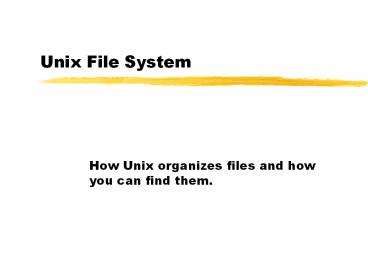Unix File System - PowerPoint PPT Presentation
1 / 11
Title:
Unix File System
Description:
Unix File System How Unix organizes files and how you can find them. ... Software for the shell and most common Unix commands. dev: Short for devices, ... – PowerPoint PPT presentation
Number of Views:311
Avg rating:3.0/5.0
Title: Unix File System
1
Unix File System
- How Unix organizes files and how you can find
them.
2
Unix file system
- Home directory
- Where your files live.
- You always go there when you log in.
- Working directory
- Whatever directory you are currently in.
3
Typical Unix file system
root (/)
bin
dev
etc
tmp
usr
var
users
classes
csfac
st
fac
staff
spool
ugrad
ms
phd
cs290
jimd
001
(all users mail)
(all people in this class)
4
Typical Directories
- bin Software for the shell and most common Unix
commands. - dev Short for devices, holds the software
necessary to operate peripherals such as printers
and terminals. - etc Contains various administrative files such
as lists of user names and passwords. - usr/users Contains the home directories of
users. - tmp A directory used to hold temporary files.
- var Files that contain information that varies
frequently most commonly, mail directories.
5
File and Directory Names
- Valid names can be made up of
- Uppercase letters (A to Z)
- Lower case letters (a to z)
- Numbers (0 to 9)
- period (.), underscore (_), commas (,).
- Should not contain spaces or the following
- \ lt gt ( ) ? / !
- You should also avoid naming files or directories
with Unix commands.
6
Absolute Pathnames
- To use a file in Unix, all you need is its name.
- To access a file in another directory, you need
to know its pathname. - A pathname is an address that shows the files
position in the file system. - Absolute path names give a files location in
relation to the top of the file system structure.
- All absolute path names begin with a /.
- Also called full path names.
- Use the as a shortcut for the full path to a
home directory.
7
Example Directory Structure
root (/)
bin
etc
var
tmp
dev
home
usr
jill
jack
marsupials
Bats
continents
oceans
kangaroo
wombat
bandicoot
opossum
wombat
8
Absolute Pathnames
- All absolute path names begin with a /.
- Also called full path names.
- Use the as a shortcut for the full path to a
home directory.
9
Relative path names
- Usually you are interested in a files location
relative to where you currently are in the
system. - A relative pathnames start at the working
directory rather than the root. - Use the .. to refer to the parent of the current
directory.
10
Example Directory Structure
root (/)
bin
etc
var
tmp
dev
home
usr
jill
jack
marsupials
Bats
continents
oceans
kangaroo
wombat
bandicoot
opossum
wombat
11
Reading
- Chapter 6.1 6.5
- Manipulating Files and Directories































